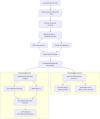Mitophagy in Hypertensive Cardiac Hypertrophy: Mechanisms and Therapeutic Implications
- PMID: 40823764
- PMCID: PMC12358939
- DOI: 10.1111/jch.70127
Mitophagy in Hypertensive Cardiac Hypertrophy: Mechanisms and Therapeutic Implications
Abstract
Hypertensive cardiac hypertrophy (HCH) is a compensatory response to chronic pressure overload, ultimately progressing to heart failure if left unmanaged. Emerging evidence highlights the critical role of mitochondrial dysfunction in HCH pathogenesis, with impaired mitophagy-a selective autophagic process that removes damaged mitochondria-contributing to cardiomyocyte death, oxidative stress, and fibrosis. Protective mitophagy eliminates damaged mitochondria, averting reactive oxygen species (ROS)/calcium overload in HCH. Conversely, its dysregulation-either insufficient clearance or excessive removal-exacerbates mitochondrial dysfunction, driving pathological hypertrophy, fibrosis, and bioenergetic crisis. This dual nature presents a therapeutic paradox demanding contextual modulation. This review comprehensively examines the molecular mechanisms underlying mitophagy dysregulation in HCH, focusing on key pathways such as PINK1/Parkin, BNIP3/NIX, and FUNDC1. We also discuss the interplay between mitophagy and other cellular processes, including mitochondrial biogenesis, inflammasome activation, and metabolic remodeling. Furthermore, we explore potential therapeutic strategies targeting mitophagy to ameliorate HCH, including pharmacological agents, lifestyle interventions, and gene therapy approaches. Understanding the dual role of mitophagy in HCH-both protective and detrimental-may pave the way for novel precision medicine strategies in cardiovascular disease.
Keywords: hypertensive cardiac hypertrophy; mitochondrial dysfunction; mitophagy; oxidative stress; therapeutic targets.
© 2025 The Author(s). The Journal of Clinical Hypertension published by Wiley Periodicals LLC.
Conflict of interest statement
The authors declare no conflicts of interest.
Figures
Similar articles
-
Comprehensive Insights Into Mitophagy: Mechanisms, Disease Associations, and Therapeutic Implications.J Cell Biochem. 2025 Jul;126(7):e70056. doi: 10.1002/jcb.70056. J Cell Biochem. 2025. PMID: 40714832 Review.
-
Mitophagy in health and disease. Molecular mechanisms, regulatory pathways, and therapeutic implications.Apoptosis. 2024 Oct;29(9-10):1415-1428. doi: 10.1007/s10495-024-01977-y. Epub 2024 May 17. Apoptosis. 2024. PMID: 38758472 Review.
-
Mitochondrial dynamics dysfunction and neurodevelopmental disorders: From pathological mechanisms to clinical translation.Neural Regen Res. 2025 Jun 19. doi: 10.4103/NRR.NRR-D-24-01422. Online ahead of print. Neural Regen Res. 2025. PMID: 40537021
-
Targeting mitophagy in the heart: Exploring the therapeutic potential of MicroRNAs.Mech Ageing Dev. 2025 Aug;226:112082. doi: 10.1016/j.mad.2025.112082. Epub 2025 Jun 6. Mech Ageing Dev. 2025. PMID: 40482727 Review.
-
VMP1 attenuates ferroptosis and mitochondrial dysfunction in nucleus pulposus cells through the PINK1/Parkin-mediated mitophagy pathway.J Orthop Surg Res. 2025 Jul 8;20(1):630. doi: 10.1186/s13018-025-06033-2. J Orthop Surg Res. 2025. PMID: 40629421 Free PMC article.
References
-
- Nakashima H., Shinohara K., Matsumoto S., et al., “Establishment of a HFpEF Model Using Female Dahl Salt‐Sensitive Rats: A Valuable Tool for Elucidating the Pathophysiology of HFpEF in Women,” Hypertension Research 48 (2025): 672–680. - PubMed
-
- Sigle M., Rohlfing A. K., Cruz Santos M., et al., “Targeting Cyclophilin A in the Cardiac Microenvironment Preserves Heart Function and Structure in Failing Hearts,” Circulation Research 135 (2024): 758–773. - PubMed
-
- Orekhov A. N., Poznyak A. V., Sobenin I. A., et al., “Mitochondrion as a Selective Target for the Treatment of Atherosclerosis: Role of Mitochondrial DNA Mutations and Defective Mitophagy in the Pathogenesis of Atherosclerosis and Chronic Inflammation,” Current Neuropharmacology 18 (2020): 1064–1075. - PMC - PubMed
Publication types
LinkOut - more resources
Full Text Sources



